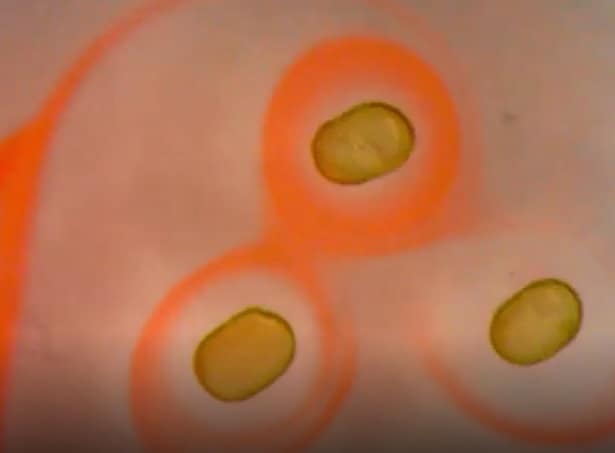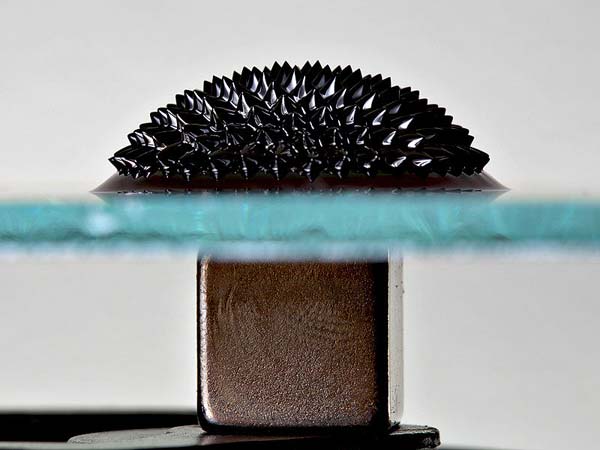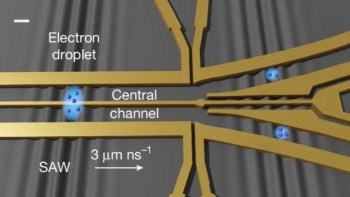
Permanent magnets made of small droplets of liquid have been created and studied by scientists in the US and China. The researchers believe that these are the first-ever liquid permanent magnets to be made. The shapes of the magnetized droplets can be changed, and this could lead to practical applications such as actuators for tiny soft robots.
Many materials have magnetic moments that line up when exposed to an external magnetic field. In a ferromagnetic material (a permanent magnet), coupling between moments ensures that the material remains magnetic after the field has been removed. In other materials called paramagnets, thermal fluctuations quickly overcome the coupling once the external field has been removed and the material ceases to be magnetic.
Ferrofluids are paramagnets that consist of magnetic nanoparticles dispersed in a liquid. When exposed to a magnetic field, the combined effects of gravity, surface tension and the magnetic attraction between nanoparticles can create unusual spiky structures on the surfaces of ferrofluids. However, when the magnetic field is removed, ferrofluids return to a normal liquid state.
Rocket fuel
The first ferrofluids were created in the 1960s by a NASA scientist so that a magnetic field could be used transfer liquid fuel in low-gravity environments. While this use never came to fruition, ferrofluids have found several niche applications in more recent years – such as vacuum seals and dampers for loudspeakers. But the latest research could potentially give the materials a much wider range of uses.
Thomas Russell of the University of Massachusetts Amherst and Xubo Liu of the Beijing University of Chemical Technology made their discovery while working with scientists at the Lawrence Berkeley National Laboratory in California. The researchers were developing ways to create durable structures of one liquid within another by using a surfactant to create a layer of particles to surround the interior structure and prevent it from breaking up. This has allowed the researchers, for example, to create tubes of water within silicone oil.
Liu decided to try this with ferrofluids so that the structures could be manipulated magnetically. Using a 3D printer with an adapted nozzle, Liu injected millimeter-sized water droplets containing billions of iron oxide nanoparticles into toluene oil mixed with a surfactant. Normally the nanoparticles would simply diffuse within the droplets, but the surfactant pinned some of the nanoparticles to the inside of the droplets’ surface. As the nanoparticles built up, they jammed together and stopped moving, creating a kind of solid crust around the edge of the droplets.
Big surprise
Liu applied a magnetic field and found, as expected, that the droplets became magnetized. But the big surprise came when the field was switched off. Making measurements with a magnetometer, Liu discovered that droplets retained some amount of magnetization in the absence of an applied field.
Russell points out that the moments of the nanoparticles within the crust might be expected to retain a slight coupling once the field is removed, given how closely packed they are. But when carrying out the same experiment using progressively larger droplets, he and Liu observed that the remnant magnetization increased roughly in line with the droplets’ volume. This, he argues, implies that even the nanoparticles diffusing within the bulk of the liquid contribute to the droplets’ magnetization – and that as such the remnant magnetization is far larger than it would otherwise be.
Russell says that this is the first time anyone has observed ferromagnetism in a liquid rather than a solid. He admits that he cannot explain how the magnetism persists, given that the distance between nanoparticles within the bulk of the droplets is far larger than the typical separation of coupled moments within a solid. But he says he has no doubt that the liquid ferromagnetism is real. “There is a lot of talk about high-temperature superconductivity, but people don’t understand that either,” he adds.
Shape shifting
What is more, the shape and magnetic state of the droplets can be altered. The team transformed a ferromagnetic droplet into a cylinder by drawing it into to a narrow capillary tube, and showed the droplet remained magnetic by exposing it to a rotating magnetic field. They then turned the droplet back into a sphere by increasing the pH of the oil mixture to unstick the surfactants and nanoparticles. This also demagnetized the droplet, but they were able to remagnetize it with a simple bar magnet.

Ferrofluid pump has no moving parts
The team describes the research in Science and writing in an accompanying commentary article, Rémi Dreyfus of the CNRS in France and University of Pennsylvania says that the new research “challenges the established physics that ferromagnetic magnets can only be made of hard materials”. He also says that the work could have several applications, such as in the growing field of soft robotics – potentially allowing bulky pneumatic equipment to be replaced by smaller magnetically-operated actuators.
Dreyfus tells Physics World that the observed remnant magnetization is “puzzling” but says the lack of a clear explanation does not undermine the results. “The published data provided by the authors seem convincing to me,” he says.
Nevertheless, Russell says that he plans on getting to the bottom of the mystery. There are several tools that could be used to study the magnetic behavior inside the droplets, he says, including neutron scattering and electron microscopy. “There is quite strong interest in these materials,” he adds, “so I’m fairly confident we can get to the underpinning of this entire process”.



